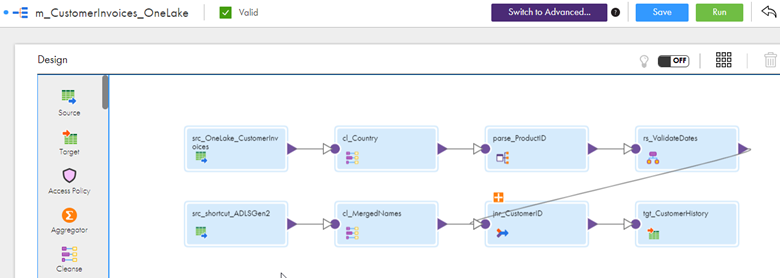Get the Most out of Your Data with Informatica IDMC and Microsoft Fabric

In today's data-centric landscape, organizations seek seamless integration solutions to harness the full potential of their data assets. These integrations are essential for the achievement of enhanced data consistency, real-time accessibility and the facilitation of more informed decision-making processes. The Informatica Intelligent Data Management Cloud™ (IDMC) platform offers a comprehensive suite of tools for efficient data management, while Microsoft Fabric, a cloud-based SaaS, provides data and analytics tools that organizations need. By integrating IDMC with Microsoft Fabric, businesses can unlock new levels of agility, scalability and reliability to enhance their data management capabilities and handle the growing volumes of data generated by modern applications.
In this blog, we'll explore the seamless integration between various services within IDMC and Microsoft Fabric and the resulting benefits.
Microsoft Fabric and IDMC Synergy
Microsoft Fabric serves as a holistic analytics solution catering to enterprise needs, encompassing data movement, data science, real-time analytics and business intelligence. It provides a comprehensive range of services, including data lake management, data engineering and data integration, consolidated within a single platform for enhanced efficiency and seamless operations.
As shown in Figure 1, the high-level architecture design illustrates lakehouse modernization with Microsoft Fabric, and the integration of various services within Informatica IDMC. While IDMC services like Data Governance and Master Data Management (MDM) integration with Microsoft Fabric are part of our future roadmap, the current design focuses on showcasing the seamless integration capabilities between IDMC services and Microsoft Fabric.

IDMC and Microsoft Fabric Connectivity
Informatica IDMC facilitates connectivity to Microsoft Fabric through three distinct types of connectors:
- Microsoft Fabric OneLake
- Microsoft Fabric Lakehouse
- Microsoft Fabric Warehouse

In addition, IDMC boosts efficiency by providing seamless connectivity to data storage solutions. As shown in Figure 2, you can effortlessly connect to Microsoft Fabric shortcuts located on OneLake, ADLS Gen2 or AWS S3 using our Microsoft Fabric OneLake connector, eliminating the need for additional setup procedures. Utilizing the Microsoft Fabric UI, you can easily create shortcuts interactively and then reference the shortcut path in your IDMC connections to achieve easy and direct connectivity to these shortcut paths.
Informatica IDMC Cloud Mass Ingestion Service and Microsoft Fabric Onelake
This dynamic collaboration empowers organizations to effortlessly and securely ingest or replicate substantial data volumes. Cloud Mass Ingestion (CMI) facilitates seamless file ingestion into Microsoft Fabric OneLake from a diverse array of sources, including cloud-based lakes, local systems and SFTP servers for enhanced analytics and insights. See Figure 3.

IDMC Cloud Profiling and Microsoft Fabric
Informatica, the exclusive ISV Design Partner of Microsoft Fabric, ensures high-quality, trusted data through native integration and a unified experience. Users can utilize the cloud profiling service in IDMC to seamlessly profile datasets within Microsoft Fabric OneLake, uncovering potential data anomalies and irregularities. This powerful functionality empowers users to gain deep insights into their data, enabling proactive identification and resolution of issues for enhanced data quality and reliability. See Figure 4.

In addition to the cloud profiling service within IDMC, users have the flexibility to leverage native integration capabilities, allowing them to profile datasets directly within the Microsoft Fabric UI environment. Users are provided with the option to enhance data anomaly validation by incorporating natural language processing (NLP) rules into the profiling process.
This seamless integration offers users an intuitive and streamlined experience, empowering them to efficiently analyze and identify data anomalies within the Microsoft Fabric environment itself, further enhancing data quality and decision-making processes. See Figure 5.

IDMC Cloud Data Integration and Microsoft Fabric
Cloud Data Integration seamlessly integrates Microsoft Fabric OneLake, Microsoft Fabric Lakehouse and Microsoft Fabric Warehouse into data pipelines, serving as both sources and targets while facilitating data transformations. This versatile capability enables organizations to construct robust data pipelines that span across on-premises and hybrid cloud ecosystems, empowering them to leverage Microsoft Fabric connections for comprehensive data integration solutions.
As shown in Figure 6, a sample data pipeline demonstrates loading data from Microsoft Fabric OneLake to Microsoft Fabric Lakehouse, incorporating essential data quality (DQ) transformations such as cleanse, parse and other generic transformations. This pipeline ensures data integrity and consistency while optimizing data flow between Microsoft Fabric environments, thereby supporting organizations in achieving their data integration goals effectively and efficiently.

IDMC Cloud Data Governance & Catalog and Microsoft Fabric
Stay tuned for exciting developments in our product roadmap, where we'll be integrating the Informatica IDMC Cloud Data Governance & Catalog (CDGC) service with Microsoft Fabric.
Coming soon, you'll be able to effortlessly scan your Microsoft Fabric assets using the CDGC service. We're also working on a feature that allows you to integrate into CDGC data pipelines built in Cloud Data Integration (CDI).
This integration will offer a comprehensive view of end-to-end lineage for data sets, showcasing connections with both upstream and downstream systems. Keep an eye on this space for updates as we continue to enhance our offerings to better serve your data management needs .
In conclusion, the integration of IDMC with Microsoft Fabric provides a unified solution for data management, analytics and quality. This collaboration streamlines processes, enabling organizations to derive valuable insights and make informed decisions with confidence.








